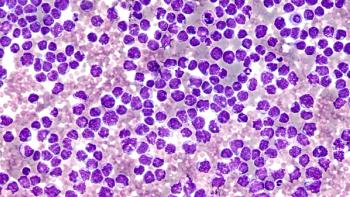
64-Protein Signature May Predict Ovarian Cancer Response to Chemotherapy
Mount Sinai researchers discovered a 64-protein signature that may help predict whether patients with high-grade serous ovarian cancers will respond to chemotherapy.
Researchers have identified a 64-protein signature that may help predict which patients with
The study was published in
As noted in the study, epithelial ovarian cancer causes more than 185,000 global deaths annually, with high-grade serous ovarian cancers (HGSOCs)—the most common subtype—accounting for 60% of these deaths. Despite advances in treatment, HGSOC mortality has not changed in the past 40 years. According to the study, between 10% and 20% of patients with HGSOC have treatment-refractory disease at the time of diagnosis, do not respond to initial therapy, and have a poor prognosis, as the 5-year survival rate remains around 30% for most patients with this type of ovarian cancer. While around 85% of HGSOC tumors respond to initial chemotherapy, most patients end up relapsing within 6 months of completing platinum-based chemotherapy.
“Despite more than 30 years of literature studying platinum resistance in cancer, there currently is no way to distinguish refractory from sensitive HGSOCs prior to therapy,” the researchers noted. “Consequently, patients with refractory disease experience the toxicity of platinum-based chemotherapy without benefit.”
To enhance comprehension surrounding chemo-refractory HGSOCs, the researchers sought to characterize the proteogenomic landscape of 242 HGSOC cases, comprised of both refractory and sensitive instances. This research spanned across 1 discovery and 2 validation cohorts, encompassing 2 distinct biospecimen types: formalin-fixed paraffin-embedded samples and frozen samples.
In doing so, the researchers unveiled a distinctive 64-protein signature capable of accurately predicting a specific subgroup of HGSOCs that exhibit resistance to initial platinum-based therapeutic interventions, detecting a subset of around 35% refractory tumors with high (98%) specificity.
They also identified a significant connection between the absence of Chromosome 17 loss of heterozygosity (Chr17-LOH) and the manifestation of chemo-refractoriness. Consistent with prior research, substantial LOH was observed across most chromosomes, but Chr17-LOH emerged as the most prevalent as it was present in around 80% of cases. Additionally, Chr17-LOH was the only LOH instance that displayed a notable and statistically significant association with chemo-sensitivity, and no other instances of gain, loss, or LOH at the chromosome level exhibited any significant correlation with the response to treatment.
By scrutinizing the protein expressions within the pathways, the study managed to identify and define 5 distinct clusters of HGSOCs. These clusters demonstrated consistency and validation in the 2 independent patient cohorts, as well as within patient-derived xenograft (PDX) models. These clusters may represent diverse mechanisms underlying refractoriness, thus implicating potential therapeutic vulnerabilities.
Each cluster had some distinct characteristics:
- Cluster 1 was associated with higher expression of translational and rRNA processing pathways
- Clusters 1 and 2 had higher cell cycle-related pathways
- Cluster 3 had higher expression of metabolic pathways and more chemo-refractory tumors (P = .027)
- Cluster 4 showed upregulation of hypoxia, EMT, and TGF-b pathways
- Clusters 4 and 5 had tumors with higher immune pathway scores
The researchers did not observe any association between the 5 clusters and tumor anatomical location, nor did they observe more frequent Chr17-LOH in tumors in clusters 1, 2, and 3 compared with clusters 4 and 5 (P = .020).
According to the authors, a higher throughput, clinical-grade, multiplexed assay is currently in development to further validate the 64-protein prediction model.
“Prior to full clinical deployment, validation of this classifier will need to be performed in additional retrospective and prospective studies, but the data from this study suggest that variability in study site and preanalytical processing procedure had limited effects on the resulting proteomic data, suggesting that the quantitative measurements will be robust in future evaluations,” they said.
Reference
Chowdhury S, Kennedy JJ, Ivey RG, et al. Proteogenomic analysis of chemo-refractory high-grade serous ovarian cancer. Cell. Published online August 3, 2023. doi:10.1016/j.cell.2023.07.004
Newsletter
Stay ahead of policy, cost, and value—subscribe to AJMC for expert insights at the intersection of clinical care and health economics.













































